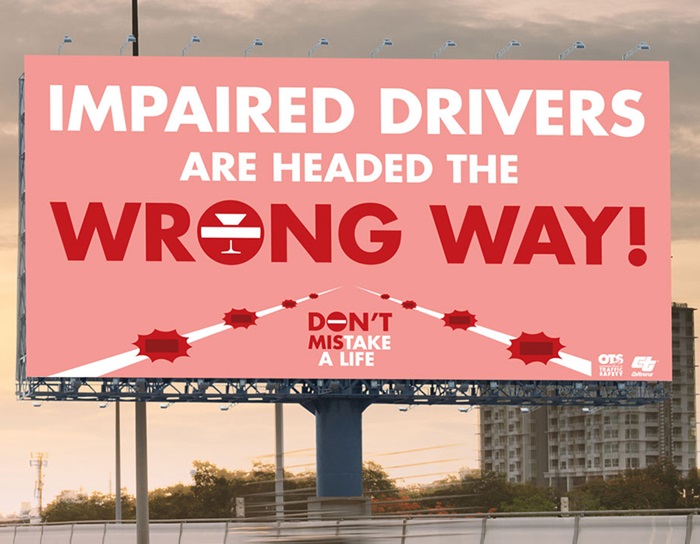District 11 looks to turn the corner on wrong-way crashes

District 11 photograph
Caltrans and the Office of Traffic Safety team up to address a flurry of such incidents in San Diego
There are few roadway scenarios as terrifying as two vehicles speeding directly toward each other and colliding head-on. The results are often catastrophic.
Perhaps the only positive thing to say about wrong-way crashes is they represent a very small percentage of highway collisions – less than one-tenth of one percent. Caltrans and its travel-safety partners are striving to further decrease the frequency of wrong-way crashes, and ideally eliminate them altogether.
In May 2022, Caltrans and the California Office of Traffic Safety (OTS) launched a wrong-way driver education and prevention campaign in San Diego County to reduce incidents of drivers entering the freeway in the wrong direction and encourage drivers not to drive impaired.
In recent years, the District 11 region has sustained a grim succession of wrong-way collisions that have been widely covered in the media and prompted calls for greater safety measures. Statewide, according to the latest available statistics, an average of 37 people die each year in wrong-way crashes. In 2019, there were 248 wrong-way crashes on California's state highways. Many of the involved drivers were under the influence of drugs or alcohol.

The safety campaign’s marketing reach has extended to public buses and many other canvases seen by those traveling in and around San Diego.
District 11 photographNationally, there were about 500 deaths per year from wrong-way driving crashes from 2015 to 2018, up 34 percent from the deaths in 2010 to 2014, according to research performed by the AAA Foundation for Traffic Safety.
Since the 1960s, Caltrans has been installing "WRONG WAY" and "DO NOT ENTER" signs at exit ramps and painting large, one-way arrows on the exit-ramp pavement. Recently, the department has installed reflectors that appear red to wrong-way drivers on freeway lanes and exit ramps.
Since 1985, Caltrans has had a robust monitoring program to investigate wrong-way driving incidents. The department uses collision data to identify problem locations and sends teams of engineers out to review the location and recommend solutions. These teams of engineers determine if simple fixes are in order, such as more signs, markings, and lighting. In some cases, Caltrans might even change the alignment of exit ramps and roadways.
In 2017, Caltrans conducted a pilot program in San Diego and Sacramento in which it installed specialized red reflective on the back side of pavement markers, detection systems and illuminated signs. The number of wrong-way drivers decreased by 44 to 64 percent during the pilot program depending on the type of enhancement.
The reflective markers proved to be so effective that Caltrans made them part of the current standards for exit ramps in California and has installed them on many exit ramps throughout the state, including almost 700 in District 11 as of this summer. Caltrans has allocated nearly $9 million toward wrong-way driver prevention upgrades such as red pavement reflectors and larger wrong-way warning signs.
As part of efforts to prevent wrong-way driving launched in 2022, District 11 worked through a Director's Order to upgrade and expand wrong-way driver infrastructure for more than 90 exit ramps on various routes in San Diego County that have experienced wrong-way driving events.
The driving public may not see the innovative technology Caltrans crews are installing since much of the infrastructure, like the red reflectors on the pavement and the flashing “DO NOT ENTER/WRONG WAY” signs, are only meant to be seen when driving the wrong way.
Most of the installations were performed overnight or on weekends, when traffic was projected to be at its lightest, and efforts were made to minimize the public impacts.
Caltrans will continue to monitor and evaluate the newly installed enhancements. Signage and red reflective markers, however bright, blinking and omnipresent they are, will not alone eliminate wrong-way driving. Motorists have to be educated about the danger of driving under the influence and respect the perils that wrong-way driving poses. With that in mind, Caltrans has teamed with organizations that include the California Highway Patrol (CHP), Mothers Against Drunk Drivers (MADD), and the OTS to develop a public campaign effort.
The campaign featured the tagline "DON'T MISTAKE A LIFE" to remind people not to make a mistake and end up taking someone's life by entering the freeway in the wrong direction. The campaign also features headlines such as "RED REFLECTORS MEAN WRONG WAY" and "IMPAIRED DRIVERS MAKE WRONG WAY DRIVERS" to bring context to the message. The campaign includes billboards, social media, advertising on buses, print advertising and transit shelters.
Here are some wrong-way-wary practices to observe when you are driving:
- If you see a wrong-way driver, move as quickly and as safely out of the way as possible. As soon as it is safe to do so, call 911 and report the driver.
- Maintain a high visual horizon to scan the environment on the road far ahead of where you are driving. This increases your ability to see roadway hazards far ahead and safely get out of the way.
- Most importantly, avoid distractions, pay attention, and don't drive while impaired.
Source: Stephen Welborn, District 11 information officer

